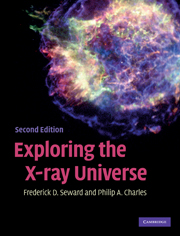Book contents
- Frontmatter
- Contents
- List of acronyms
- Foreword
- Chapter 1 Birth and childhood of X-ray astronomy
- Chapter 2 X-ray emission and interaction with matter
- Chapter 3 Tools and techniques
- Chapter 4 Solar system X-rays
- Chapter 5 X-ray absorption and scattering in the Interstellar Medium
- Chapter 6 Active stellar coronae
- Chapter 7 Early-type stars
- Chapter 8 Supernova explosions and their remnants
- Chapter 9 Neutron stars, pulsars, pulsar wind nebulae, and more supernova remnants
- Chapter 10 Cataclysmic variable stars
- Chapter 11 X-ray binaries
- Chapter 12 Black-hole X-ray binaries
- Chapter 13 Normal and starburst galaxies
- Chapter 14 Active galactic nuclei
- Chapter 15 Clusters of galaxies
- Chapter 16 The diffuse X-ray background
- Chapter 17 Gamma-ray bursts
- Index
- Plate section
Chapter 10 - Cataclysmic variable stars
Published online by Cambridge University Press: 05 June 2012
- Frontmatter
- Contents
- List of acronyms
- Foreword
- Chapter 1 Birth and childhood of X-ray astronomy
- Chapter 2 X-ray emission and interaction with matter
- Chapter 3 Tools and techniques
- Chapter 4 Solar system X-rays
- Chapter 5 X-ray absorption and scattering in the Interstellar Medium
- Chapter 6 Active stellar coronae
- Chapter 7 Early-type stars
- Chapter 8 Supernova explosions and their remnants
- Chapter 9 Neutron stars, pulsars, pulsar wind nebulae, and more supernova remnants
- Chapter 10 Cataclysmic variable stars
- Chapter 11 X-ray binaries
- Chapter 12 Black-hole X-ray binaries
- Chapter 13 Normal and starburst galaxies
- Chapter 14 Active galactic nuclei
- Chapter 15 Clusters of galaxies
- Chapter 16 The diffuse X-ray background
- Chapter 17 Gamma-ray bursts
- Index
- Plate section
Summary
Introduction
Cataclysmic variables are remarkably similar to the low-mass X-ray binaries (LMXBs) described in Chapter 11 but are significantly less luminous in X-rays, particularly at the higher X-ray energies of the first X-ray satellites. Indeed, only one previously known CV, EX Hya, was found in the Uhuru survey of the X-ray sky. But these objects have a long history that goes back well before the era of X-ray astronomy, as they include among their number both dwarf novae and novae. As we shall see in this chapter, dwarf novae and novae are powered by fundamentally different processes than occur in supernova events. Supernovae represent the final, and irreversible, moments in the lives of massive stars, when they collapse rapidly under gravity and then explode catastrophically. For any given object it happens once, whereas nova and dwarf nova eruptions can and do recur. Indeed, it is hypothesised that all novae recur, but the typical recurrence time is long: at least hundreds, perhaps thousands, of years.
Cataclysmic variables are interacting binaries similar to LMXBs, except that the compact object is a white dwarf, accreting material from its (usually) cool, late-type companion star in a short period (approximately hours) binary system. They are one of the few classes of object in this book that were known and observed prior to the twentieth century. Novae have been known to mankind throughout history, and dwarf novae were first recorded in the mid-nineteenth century.
- Type
- Chapter
- Information
- Exploring the X-ray Universe , pp. 143 - 170Publisher: Cambridge University PressPrint publication year: 2010



